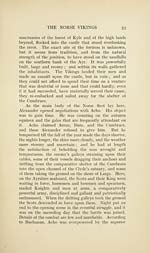Download files
Complete book:
Individual page:
Thumbnail gallery: Grid view | List view

54 HISTORY OF AYRSHIRE
numbers of the Scots, " and reduced to the shameful
necessity of flying with the greatest precipitation to his
ships." The Norwegians, he adds, " left sixteen thousand
men on the field of battle, and the Scots five." How
complete the rout was may be gathered from those
verses from the old ballad of " Hardyknute," which
tells the story of the battle : —
In thrawis of death, with wallowit chiek
All panting on the plain,
The fainting corps of warriors lay,
Neir to aryis again.
Neir to return to native land
Nae mair wi' blithesome sounds,
To boist the glories of the day,
And schew their shining wounds.
On Norway's coast the widowit dame
May wash the rocks with tears ;
May long look ower the schiples seis
Befoir her mate appears.
Ceise, lady, ceise, to hope in vain,
Thy lord lyis in the clay ;
The valyant Scots nae reivers thole
To carry life away.
The chief scene of the fight is said to have been a
plain to the south of the town, immediately below the
mansion of Haylee, but the memorials of the conflict
are not confined to this spot. In Dairy parish, adjacent
to that of Largs, there is a Camphill farm ; on a stream
known as the Routdon burn, there are Burleygate and
Killingcraig, and still further south there is Keppingburn,
where Sir Robert Boyd, one of the ancestors of the Earls
of Kilmarnock, is said to have intercepted a body of
fleeing Norsemen. There are the remains of a tumulus
known as Acho's Tomb, the authenticity of which does
not, however, seem to be very satisfactorily assured.
At one time there stood a cross at a place known as the
" Broomlands," which was supposed to have marked
numbers of the Scots, " and reduced to the shameful
necessity of flying with the greatest precipitation to his
ships." The Norwegians, he adds, " left sixteen thousand
men on the field of battle, and the Scots five." How
complete the rout was may be gathered from those
verses from the old ballad of " Hardyknute," which
tells the story of the battle : —
In thrawis of death, with wallowit chiek
All panting on the plain,
The fainting corps of warriors lay,
Neir to aryis again.
Neir to return to native land
Nae mair wi' blithesome sounds,
To boist the glories of the day,
And schew their shining wounds.
On Norway's coast the widowit dame
May wash the rocks with tears ;
May long look ower the schiples seis
Befoir her mate appears.
Ceise, lady, ceise, to hope in vain,
Thy lord lyis in the clay ;
The valyant Scots nae reivers thole
To carry life away.
The chief scene of the fight is said to have been a
plain to the south of the town, immediately below the
mansion of Haylee, but the memorials of the conflict
are not confined to this spot. In Dairy parish, adjacent
to that of Largs, there is a Camphill farm ; on a stream
known as the Routdon burn, there are Burleygate and
Killingcraig, and still further south there is Keppingburn,
where Sir Robert Boyd, one of the ancestors of the Earls
of Kilmarnock, is said to have intercepted a body of
fleeing Norsemen. There are the remains of a tumulus
known as Acho's Tomb, the authenticity of which does
not, however, seem to be very satisfactorily assured.
At one time there stood a cross at a place known as the
" Broomlands," which was supposed to have marked
Set display mode to:
![]() Universal Viewer |
Universal Viewer | ![]() Mirador |
Large image | Transcription
Mirador |
Large image | Transcription
Images and transcriptions on this page, including medium image downloads, may be used under the Creative Commons Attribution 4.0 International Licence unless otherwise stated. ![]()
| Histories of Scottish families > Ayrshire > Volume 1 > (64) Page 54 |
|---|
| Permanent URL | https://digital.nls.uk/95195054 |
|---|
| Attribution and copyright: |
|
|---|
| Description | A selection of almost 400 printed items relating to the history of Scottish families, mostly dating from the 19th and early 20th centuries. Includes memoirs, genealogies and clan histories, with a few produced by emigrant families. The earliest family history goes back to AD 916. |
|---|

